Dear reader: This article contains links to products and services that I may be compensated for, at no extra cost to you.
Temple lovers, hiking fans, and anyone looking to get a little off-the-beaten-path in Busan, you have to add Seokbulsa Temple (Seokbul Temple, more correctly, since “–sa” means “temple”) to your Busan bucket list.
This is no ordinary Korean temple; Seokbulsa is built into the sides of sandstone cliffs on Geumjeongsan (Mt. Geumjeong), the highest mountain in Busan, and features impressive Buddha reliefs carved into the cliff walls. It is one of my personal favorites on my list of the 10 best temples to visit in Busan.
Seokbulsa is small, and you’ll probably only spend about 30 minutes or less there, but combined with the hike it makes for a great half-day trip from the city center. Comparable to Bukhansan National Park near Seoul, the hike to Seokbulsa offers incredible city views over sprawling Busan. Hiking to an observing Seokbulsa’s awe-inspiring features is an experience you won’t soon forget.
To round out the experience, you can soak in Heosimcheong Spa, one of the largest spas in the world, at the end of your experience (see the bottom of the article). In fact, the name of this district, Oncheon, means “hot spring” in Korean!
A larger and more famous temple on Mt. Geumjeong is Beomeosa, the most well-known temple in Busan. You could hike all the way from Seokbulsa to Beomeosa along the Geumjeong Mountain Fortress, but it would make for a long day. See here to read about my temple stay experience at Beomeosa.
Two other amazing temples you may want to check out in Busan are Samgwangsa, where South Korea’s most incredible lantern festival takes place, and Haedong Yonggungsa, Busan’s temple on the coast!
Find out how you can squeeze all the above-mentioned places into your trip in my detailed Busan 5-day itinerary.
Some Busan Essentials
– Read my full review of La Valse Hotel, my favorite place to stay in Busan, and my detailed guide to the best areas to stay and hotels in Busan.
– Order your SIM card or WiFi device for pickup when you arrive in South Korea. Get a discount by signing up here first.
– Save $$$ by booking your Korea Rail Pass for travel between Seoul and Busan.
– Visit another interesting temple and some top Busan sights on this full-day Busan tour.
Table of Contents
Why is Seokbulsa Temple So Special?

For starters, Seokbulsa’s inaccessibility makes it more intriguing than other Busan temples. As the crow flies, it is only about 1.5 from Mandeok subway station on Line 3, or three kilometers from Oncheonjang station on Line 1.
However, since it takes more effort to get there, fewer people go, which means you have a higher chance of having the temple almost (or entirely) to yourself. When I visited in the late morning of a national holiday, I only saw a handful of other people at the temple, and I was easily able to get pictures of the temple with nobody in the way.
The second reason why Seokbulsa is so special is that it is completely unlike any other Korean temple. Seokbulsa apparently dates to 1930, during the Japanese colonial occupation of Korea, which is quite recent for Korean temples. It was founded by a monk named 曺鉉, who chose the location for its unique rock formations and is responsible for the carvings now found there.
While it is possible to find carvings in cliffs at other temples in South Korea, for example Golgusa near Gyeongju, nowhere else can find them right within the city limits, and with a view, of such a large city like Busan.
The cliff carvings at Seokbulsa reminded me of the amazing cave temples of Lion’s Head Mountain in Taiwan, where I live, and the impressive Ostrog Monastery in Montenegro, which is built into a sheer cliff!
Related: Read my guides to Taejongdae, Busan’s most famous coastal park, and Gamcheon Culture Village, the city’s most colorful attraction.
How to Get to Seokbulsa Temple
Getting to Seokbulsa can be done in several ways. The faster but less interesting way is to walk from Mandeok subway station. I can’t say how long it takes because I haven’t done it, but it’s a 2.4-kilometer walk uphill on a winding vehicle road. I would guess it might take about an hour (please let me know in the comments if you’ve done it and how long it took you!)
Another way is the longer but more interesting and scenic route that involves walking from Oncheonjang subway station and taking the Geumgang Cable Car in Geumgang Park up Geumjeong Mountain, then hiking the rest of the way.
Yet another is this completely different route on AllTrails, which starts in the north at Geumjeongsanseong Fortress East Gate and works its way south to Seokbulsa then finishes at Mandeok subway.
In total the trip to Seokbulsa took me five hours return from Oncheonjang subway station, but you could probably do it in four hours if you are a fast walker and don’t stop much or get lost (see below).
Getting to Oncheonjang and the Geumgang Cable Car
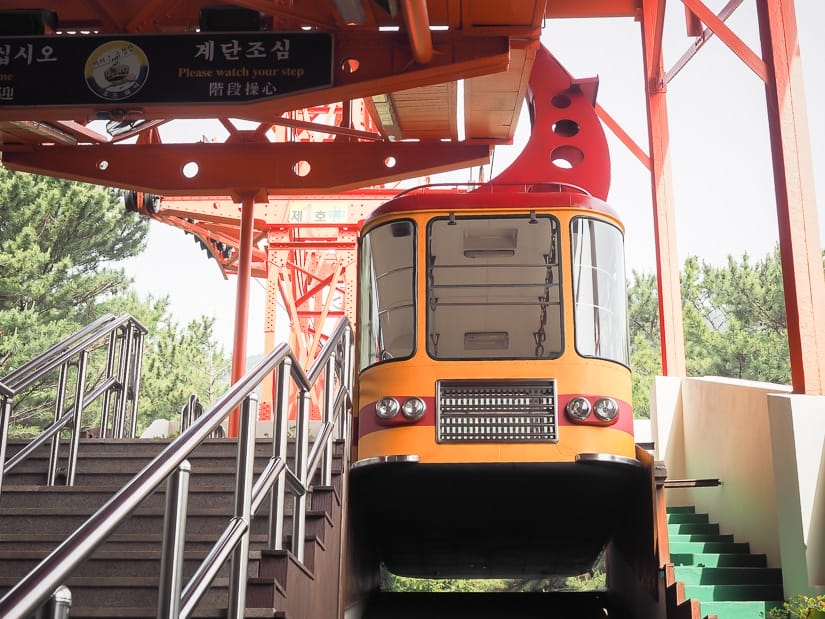
It takes 17/33/46 minutes to reach Oncheonjang station from Seomyeon/Nampo/Haeundae subway stations.
I enjoyed a breakfast of eomuk (fish cakes) and gimbap (sushi rolls) from the vendor right inside the Oncheonjang station. I’m glad I did this, because there wasn’t much else open in the morning on the way to the cable car.
From Oncheonjang subway station, take exit 1 and walk south. Cross the main road at the first major intersection that you reach and walk uphill towards Geumjeong Mountain (Geumjeongsan). The road makes a few slight turns and reaches a few intersections, but you can’t really go wrong if you just keep walking uphill.
The road gets narrowing as you go up, and eventually you’ll reach Ujangchun-ro, the street which forms the border of Geumgang Park. From the park entrance, follow the signs to the Geumgang Park Ropeway. All in all, it took me 20 minutes to reach the cable car from the subway exit.
For another awesome cable car experience in South Korea, check out the Seoraksan Cable Car in Seoraksan National Park!
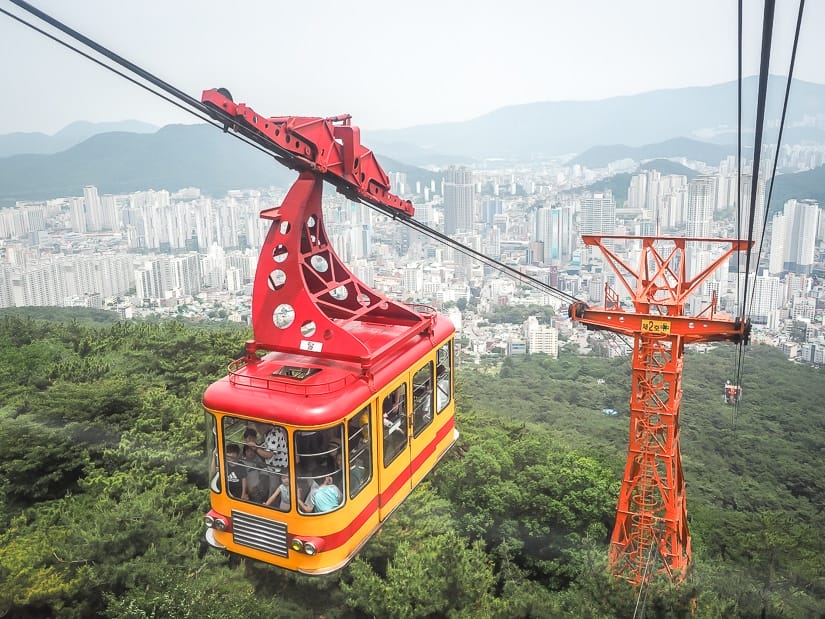
The Geumgang Ropeway is the longest in Korea. It’s a funky, retro looking car and there are only two of them making the six-minute journey up and down. They leave roughly every 20 minutes from 9 AM to 6 PM (it didn’t run until 9:30 when I visited on a holiday). A ride now costs 9000 won (return) or 6000 won (one-way), 1000 higher than it cost not too long ago.
I’m guessing the cable car can hold about 20 people, and some of the windows even open up so you can actually take some decent pictures. The car rises very steeply, so it only takes a few seconds before you begin enjoying dramatic views over sprawling Busan.
Hiking to Seokbulsa
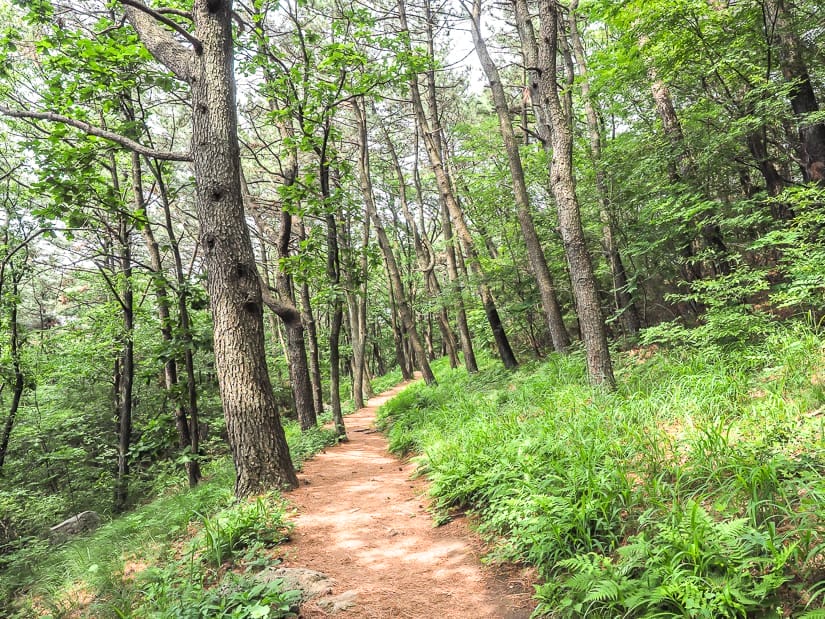
From the top of the cable car, the 3.2-km hike to Seokbulsa took me about 1.5 hours, but I wasted 15 minutes getting lost, which of course I’ll now explain how NOT to do.
The hike can basically be divided into three sections. The first section is a 1.3-km easy stroll through the forest to Namun Gate (South Gate), the southern gate of Geumjeongsanseong, or Geumjeong Mountain Fortress, which is the largest mountain fortress in South Korea remaining today.
Departing from the cable car station, I simply followed the signs to Namun Gate. The part I got lost was only a few minutes in, when the trail reached a triangular intersection, with a choice to go left or right. I only saw signs in Korean pointing to the left direction (none of which said Namun), so I went with my gut feeling and turned left. My gut feeling was wrong, and it wasn’t until a good 10 minutes in that I asked a random elderly hiker (of which you’ll find many on Geumjeongsan) and found out I’d gone the wrong way.
So at the triangular intersection, make sure you go right.
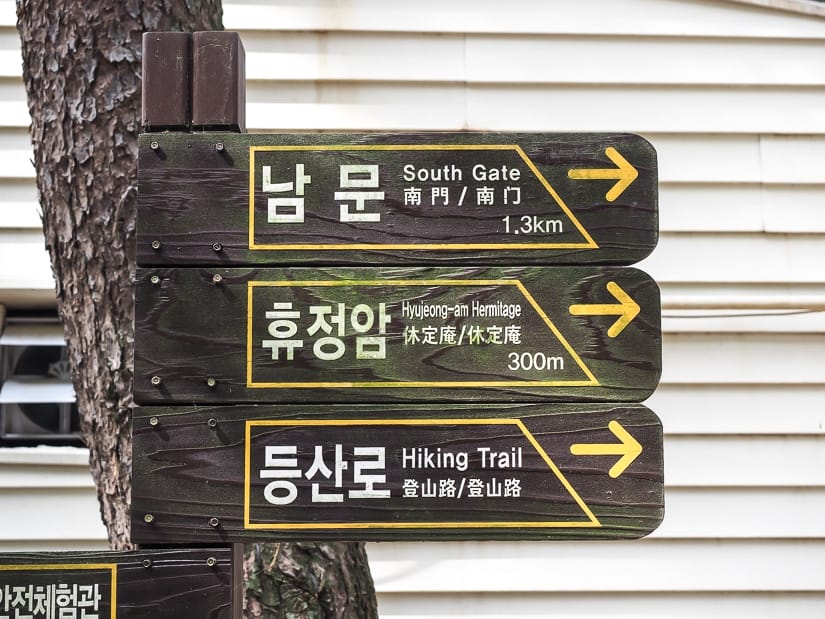
Once I got back to that intersection, I realized the right side actually did have a sign for Namum Gate, but in a spot on the side where it is easily missed.
From there, signs led me all the way to Namun Gate. Reaching the gate, I didn’t actually go through it, but instead follow the paved road downhill towards Namun Village. Namun Gate is the start of the second section of the hike, the 1.3-km downhill portion.
The road soon reached Namun Village, where there were a half-dozen simple Korean restaurants for hikers. Around lunch, they were overflowing with locals eating and drinking boisterously. By the way, I have to point out that one thing I love about Korea is how hiking and drinking seems to go hand-in-hand.
At the end of the village, the path dead-ends at a fence, and I had a choice to go left or right. Go right here, and then immediately left to continue walking downhill in the same direction. The path then went more steeply downhill along a lovely creek and finally reached a vehicle road, which is the end of the second section.

The third and final section of the hike to Seokbulsa will surely be your least favorite. This is a very steep 0.6-kilometer ascent on a winding paved road. Huffing and puffing, I was very pleased to find a random cold drink machine just a few hundred meters before reaching Seokbulsa. If you happen to be coming by car, you could pretty much drive right up to this point.
Seokbulsa Temple
The first sign of the temple I saw, besides a few engraved rocks along the road (see photo above), was a bell pavilion to my left (every temple in Korea’s got a big bell), and a large locked door on the right with Buddhist swastikas on it that once must have been the entrance to the temple.
Up one more turn, I reached the entrance gate, rather plain looking monk’s quarters of Seokbulsa, and another bell pavilion. From here, one can enjoy impressive views of Busan, including as far as Gwangalli bridge, supposedly, on a clear day. It was cloudy when I visited, though, so the view wasn’t great.
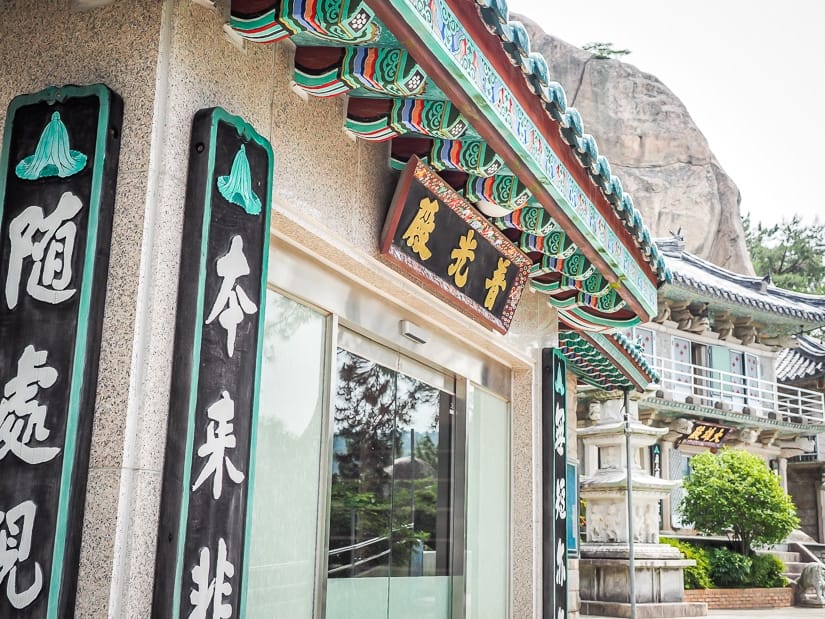
What people really come for is the section at the back. First I noticed the rather small, two-story Main Hall. The first floor of the structure had a steep cave entrance going down into the back of it, while the second floor was eerily filled with rows upon rows of nearly identical Buddha statues. Across from the Main Hall is another similar sized building with a small meditation room open on the second floor.
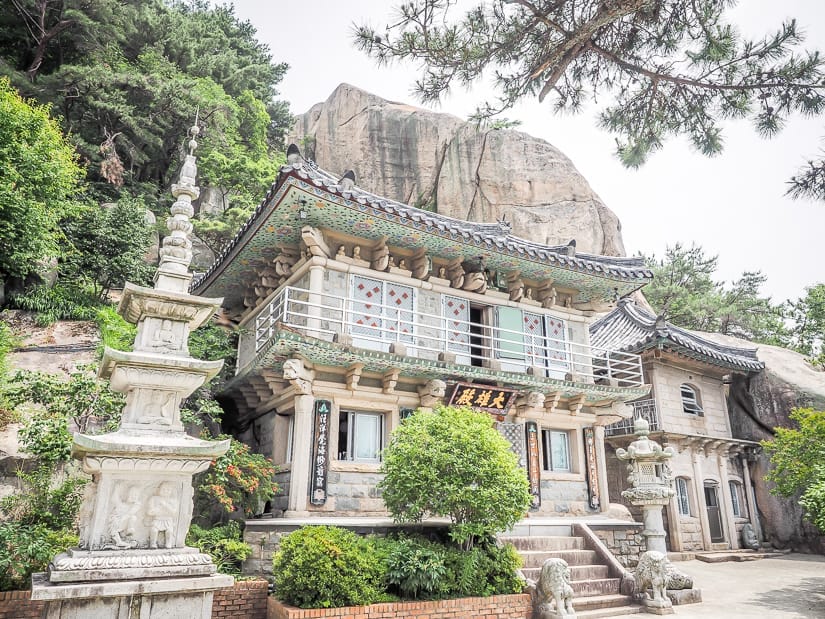
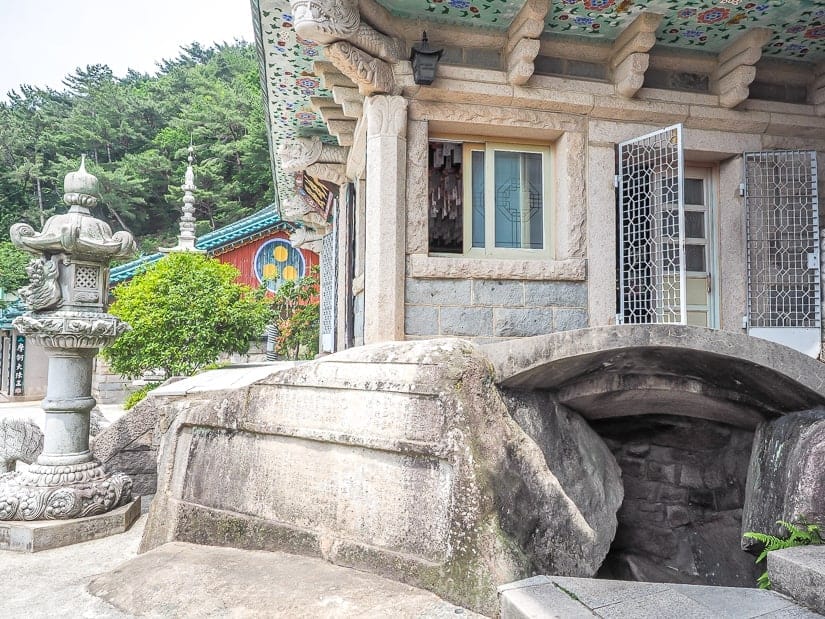
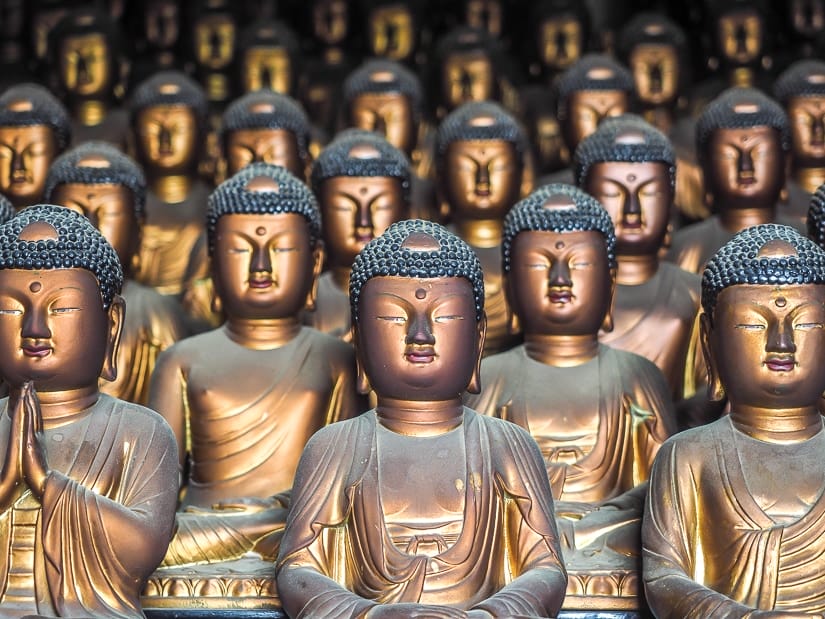
Walking between the latter two buildings, I followed a staircase up into a steep alcove flanked by sandstone cliffs on either side. Both sides are carved with gorgeous, 10-meter reliefs of Buddhas and temple guardians. A lone woman was doing prostrations on a mat to the most important carving, one of Gwanseeum-bosal (the Bodhisattva of Compassion).
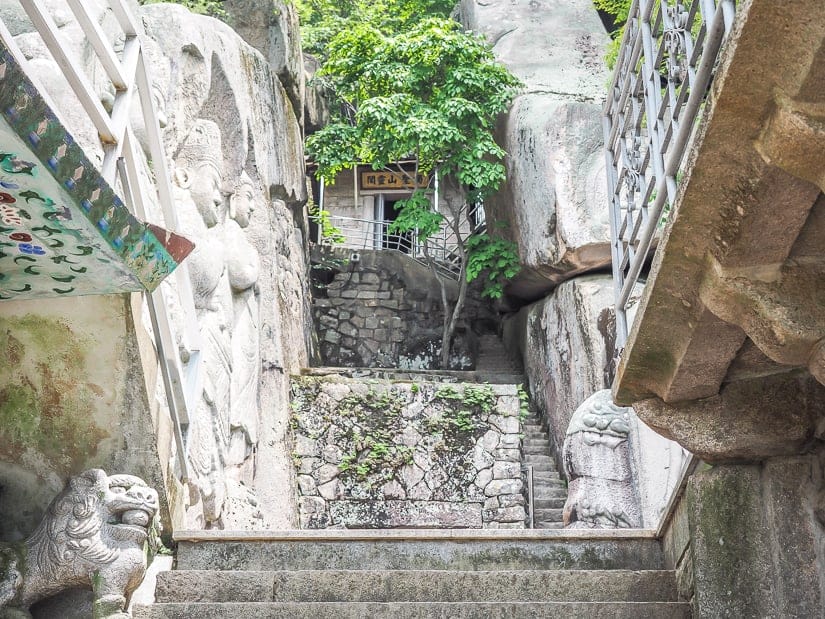



In between two caves with flickering candles and more statues, an even steeper staircase led to a small terrace and a final worship room. From this spot, I turned around to take in Seokbulsa’s classic view, with the large carvings on either side of me, lush mountains in the distance, and little slice of Busan visible far, far below. I’ve purposely not included a shot of the final view, so you can enjoy the surprise when you go 🙂
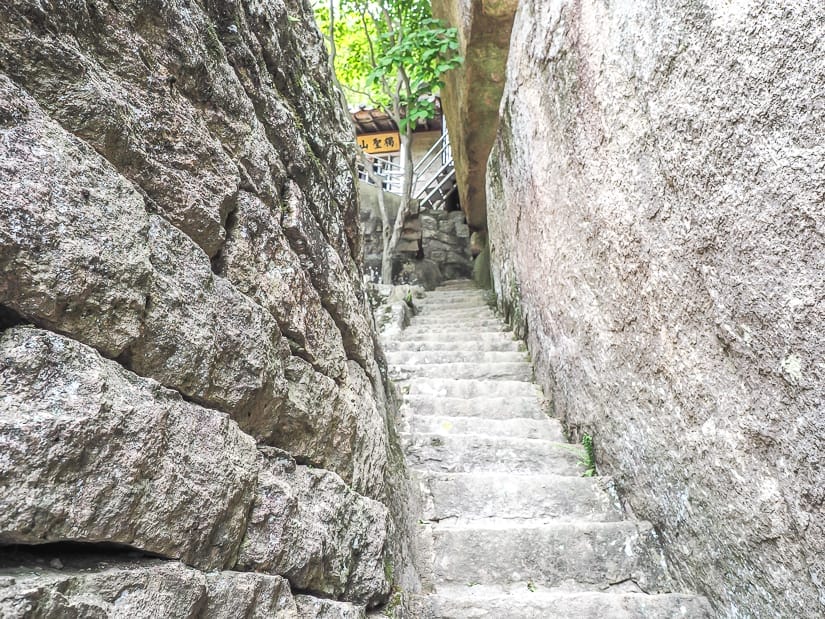
Going Back Down
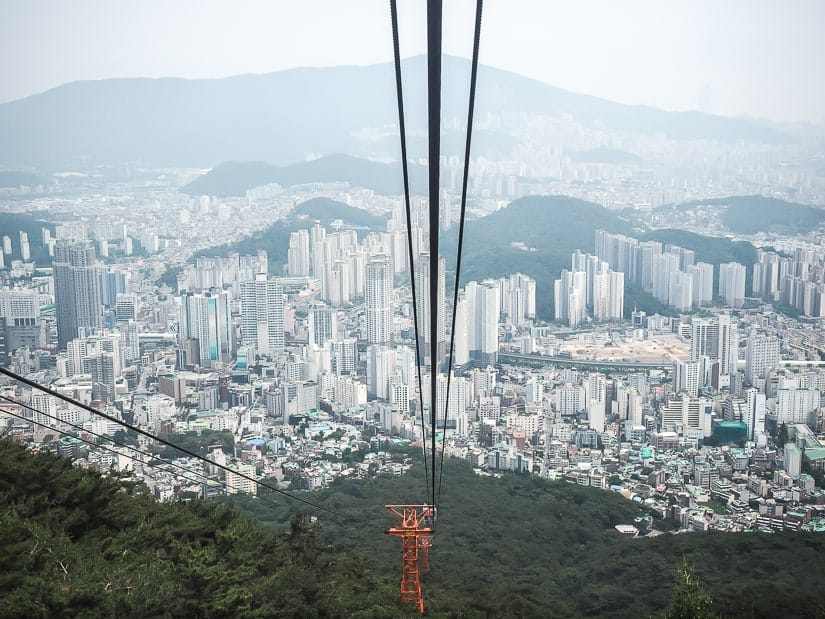
The return hike to the Geumgang Park Ropeway only took me about an hour. Of course the second section, which had been downhill on the way in, was now an uphill slog. If you want to skip the return hike to the cable car, then simply follow the paved road from Seokbulsa all the way down to the city, where you can reach Mandeok subway station in about an hour.
Once you take the cable car back down to Geumgang Park, there are a few different activities I’d recommend in the area before heading back to Oncheonjang subway station.
First, if you are starving like I was, head directly to Somunnan Dongnae Pajeon restaurant. It’s a popular spot that specializes in dongne pajeon, or seafood pancakes with long strips of green onion in them.

Their pajeon are huge, and easily shared between two people (I often found eating in Korean restaurants tough as a solo traveler. The portions were always too big, not to mention all the little side dishes they give you!) Lots of guests also seemed to be enjoying makgeolli, a kind of creamy rice wine that comes in a plastic bottle, but I stuck to an ice cold beer.
Second, if your feet are sore, why not soak them in a public foot bath at Dongnae Outdoor Footbath (10 AM to 5 PM, closed Wednesday and Friday)?
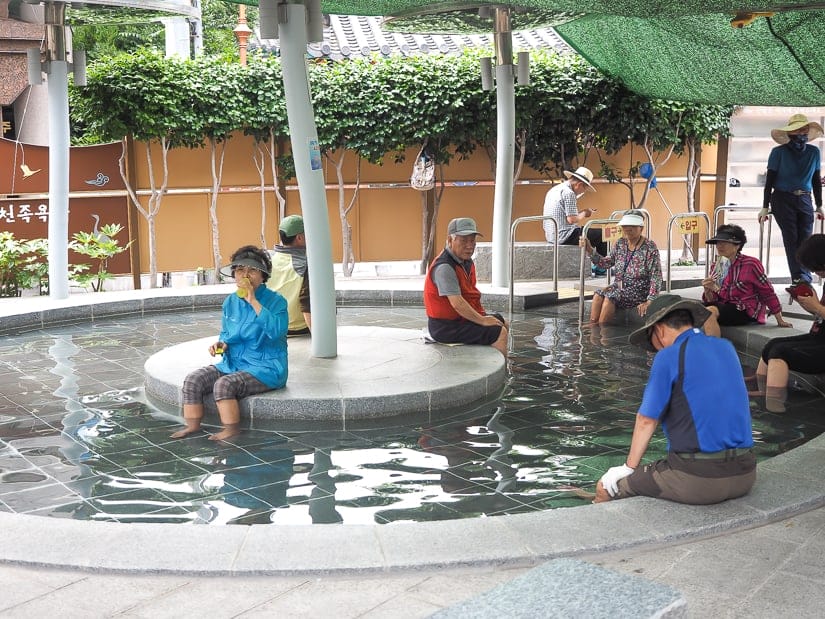
Desiring a full-body soak, I passed Dongnae Outdoor Footbath in favor of Heosimcheong Spa (also spelled Hurshimchung Spa), which at one point was considered the world’s largest spa, and is still definitely one or the largest.
Supposedly the newer Spa Land at Shinsegae Centum City Department Store (the largest department store in the world) also in Busan is even larger than Heosimcheong Spa, but I’ve heard that die-hard hot spring lovers still prefer Heosimcheong.

For 10,000 won (12,000 on weekends), I got access to a gorgeous domed facility that contains dozens of different hot baths, massage tubs, steam rooms, saunas, and cold baths. After checking in I received a key bracelet, which worked for a shoe locker and also regular locker in the change room, for all my clothes and things.
That’s right, like all Korean bathhouses, you must get totally naked, and of course the baths are sex segregated.For more details on what to expect in a Korean bathhouse, see this guide to Korean jimjilbang.
Next, I entered the large domed public area and started by taking a very thorough shower, which is the custom. Soap, shampoo, and scrubbing towels are provided. Then I soaked in various pools to my heart’s content! I even enjoyed an ice cream and iced coffee while lying on a sun deck in the nude. You simply swipe your key chain and settle the bill at the end.
Even though I’ve been to nude hot springs in Asia many times, I must admit it was still a bit of a shock for me to see SO MANY naked people all at the same time, with nobody showing even a hint of embarrassment. And I didn’t even get (too many) stares for being the only white (and super hairy) guy.
Don’t knock the experience till you try it, and if you’re going to try a Korean bathhouse, why not make it the best at Heosimcheong Spa? Nothing beats a soothing hot spring soak after a rigorous hike!
Heosimcheong Spa is in between Geumgang Park and Oncheonjang subway station, so it’s pretty much on the way. You can get a discount if you buy your spa tickets in advance here.
Last, the Busan Marine Natural History Museum is also in the neighborhood, but I was far too relaxed after my hot spring soak at Heosimcheong to want to bother 🙂

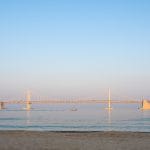
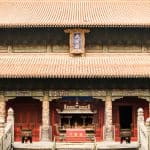
Thanks for your Seokbulsa Temple information. The information for visiting Korea keeps improving!
Takes me back a little, I worked in Busan, visited Seokbulsa several times. I always used the Mandeok station. If I recall correctly, it is the only subway stop in Busan that requires an elevator to reach the street. The station is too deep for escalators.
The walk to the temple is not complicated, maybe not boring either. Can we say it is routine? There are some nice views on the walk, especially if one is climbing during the cherry blossom season. Be prepared for a steep walk, 1 hour is fair.
Hi Tom, thanks for reading and for the tips and feedback!
I remember that drink machine… 😉 And I think I got lost at the same spot, but proceeded to a lot of climbing.
If I want to do one way the short way and the other the long hike, which order do you recommend? Hike first then the easy paved road or the opposite? I’m not much a hiker lol
I would go for the cable car & longer way going up, which is more enjoyable, and then do that shorter, deeper, less interesting part as a quick downhill at the end.